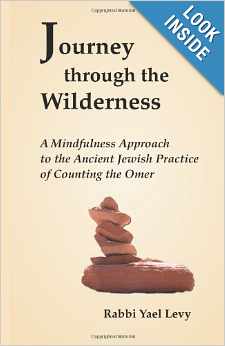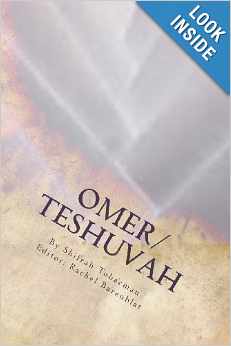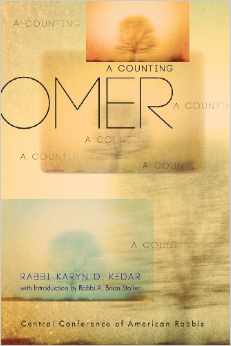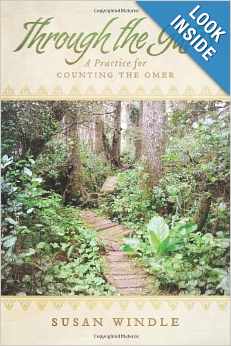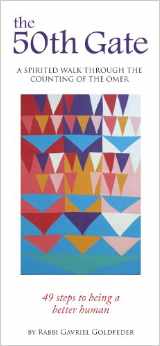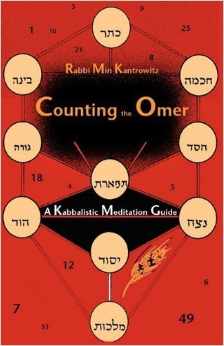-
Journey Through The Wilderness
Open or Closeby Rabbi Yael Levy
Rabbi Yael Levy (a member of my cohort of colleagues at IJS) presents us with a mindfulness approach to the counting of the Omer. The guide for each day is enhanced with quotations from Psalms and a meditative practice for each day of the Omer. -
Omer / Teshuvah
Open or Closeby Shifra Tobacman
The book offers a unique twist, providing two ways of counting, with poems for each day. In addition to the traditional Omer count, one can also use the poems, in reverse order, to count the seven weeks leading up to Rosh Hashanah with its theme of "turning" or Teshuvah. Hence, the title. -
Omer: A Counting
Open or Closeby Rabbi Karyn Kedar
Rabbi Karyn Kedar and I spent the first year of our rabbinic studies in Israel together! She has gone on to author several books with Jewish spiritual themes. More than any of the other books recommended here, Omer: A Counting uses the structure of the Omer as a point of departure, breaking free of a strict reading of the various combinations of sefirot for a given day and instead suggesting a series of more accessible, contemporary analogues: Decide, Discern, Choose, Hope, Imagine, Courage and Pray. -
Through The Gates
Open or Closeby Susan Windle
This lovely book really has the feel of a diary or personal conversation with the reader. Susan Windle, who converted to Judaism in 2008 after studying with Rabbis Phyllis Berman and Shefa Gold, reflects upon each day of the Omer through original poetry and letters to friends. Very well done. -
The 50th Gate
Open or Closeby Rabbi Gavriel Goldfeder
I like this book. A lot. Goldfeder, ordained in Israel, served an "Alternadox," progressive Orthodox synagogue in Boulder, Colorado, for 10 years before recently moving on to a program position at MIT Hillel. The book's central thesis and emphasis is that derech eretz kadmah la-Torah, which he reads to mean, "being a decent human being is a prerequisite for receiving the Torah." Thus his book focuses upon using the counting of the Omer to refine one's interpersonal relations. Highly recommended. -
Counting The Omer
Open or Close -
Counting of The Omer
Open or Close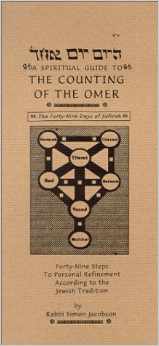
by Rabbi Simon Jacobson
Much of this material is already on Jacobson's "Meaningful Life Center" web site, but it's very nice to have this book in printed form, set up like a spiral bound calendar or notebook. The perspective is Chabad-Hasidic. -
Sefiros
Open or Close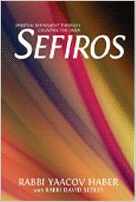
by Rabbi Yacov Haber
One of the earlier (circa 2008) books in the crop of neo-Omer tomes. Sadly seems to be out of print although available used on Amazon and elsewhere. Worth having if you can find it.
You found the secret Information Button!
Now what are you waiting for? Click here to participate in omerblog!
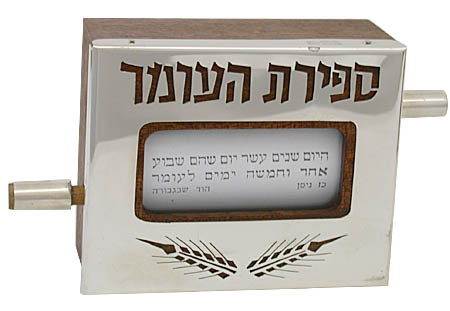
This is a rather ornate Omer Counting device. Google "omer counter" and you'll be amazed. Really.
Introducing omerblog!
omerblog is a project of Rabbi Steve Folberg, Senior Rabbi of Congregation Beth Israel of Austin, Texas.
omerblog was inspired by my experiences in the Rabbis5 cohort of the Institute for Jewish Spirituality. Forty rabbis of a variety of denominations participated in four, five-day retreats, spread over two years. On retreat we studied Hasidic texts, learned yoga and meditation in a Jewish mode, and spent time exploring silence and prayer. in between retreats, we studied texts by phone with a hevruta (study partner).
Through IJS, I was exposed for the first time to the kabbalistic tradition that the period of the Counting Of The Omer - the seven weeks from Passover through Shavuot - can be devoted, day by day, to exploring a sequence of human virtues. The spiritual practices of the Omer period have the potential to deepen our inner lives as Jews and make this period in the Jewish calendar much more meaningful.
What is the goal of omerblog?
omerblog provides an online space for Congregation Beth Israel members and those who would like to join with them to learn about the practices of the Omer period and share their experiences and insights with others.
omerblog was inspired by my experiences in the Rabbis5 cohort of the Institute for Jewish Spirituality. Forty rabbis of a variety of denominations participated in four, five-day retreats, spread over two years. On retreat we studied Hasidic texts, learned yoga and meditation in a Jewish mode, and spent time exploring silence and prayer. in between retreats, we studied texts by phone with a hevruta (study partner).
Through IJS, I was exposed for the first time to the kabbalistic tradition that the period of the Counting Of The Omer - the seven weeks from Passover through Shavuot - can be devoted, day by day, to exploring a sequence of human virtues. The spiritual practices of the Omer period have the potential to deepen our inner lives as Jews and make this period in the Jewish calendar much more meaningful.
What is the goal of omerblog?
omerblog provides an online space for Congregation Beth Israel members and those who would like to join with them to learn about the practices of the Omer period and share their experiences and insights with others.
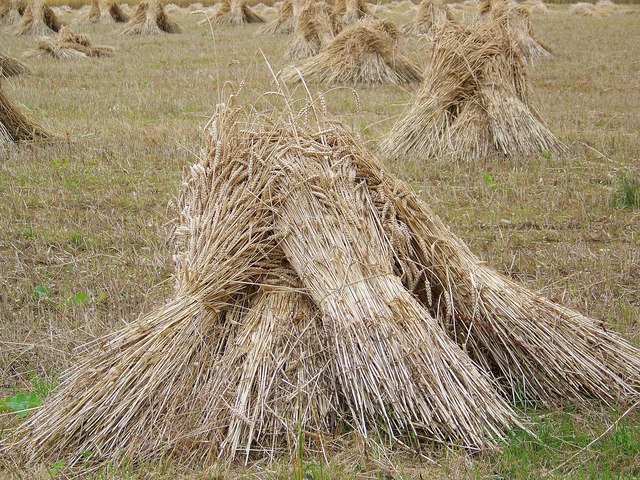
Sheaves of Wheat
(in France, actually...)
(in France, actually...)
What is the Omer?
The Counting of the Omer refers to enumerating each day of the 7 weeks between the second day of Passover (when the "omer," literally, a "measure" of the first grain from the new harvest was brought to the Temple) and the festival of Shavu'ot (a word which, literally, means "weeks") when another, crucial grain offering was made in the ancient Temple.
People were not permitted to eat the yield of the first, new grain harvest of the growing season (which in Israel would have been barley) until the first omer measure of barley was brought to the Temple on the second day of Pesach. And then, forty-nine days later, the Temple meal offerings from the new wheat crop (which would have been the second grain to ripen) were only offered once the שְׁתֵי הַלֶּחֶם, the first two loaves baked with the new wheat crop, were offered in the Temple on Shavu'ot.
People were not permitted to eat the yield of the first, new grain harvest of the growing season (which in Israel would have been barley) until the first omer measure of barley was brought to the Temple on the second day of Pesach. And then, forty-nine days later, the Temple meal offerings from the new wheat crop (which would have been the second grain to ripen) were only offered once the שְׁתֵי הַלֶּחֶם, the first two loaves baked with the new wheat crop, were offered in the Temple on Shavu'ot.
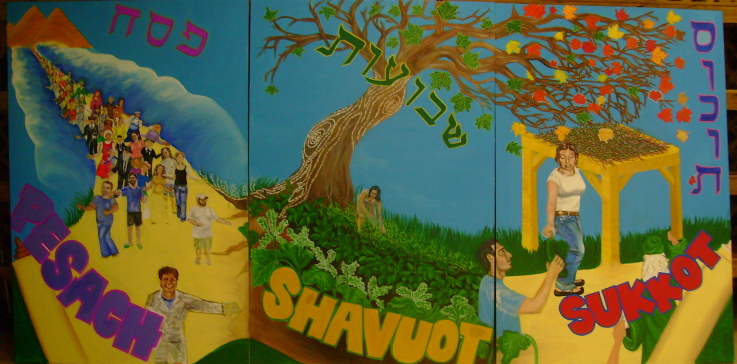
Didja know?...
Shavu'ot is one of the Shalosh Regalim, the 3 Pilgrimage Festivals in the Torah. The other two are Pesach (Passover) and Sukkot (The Feast Of Booths).
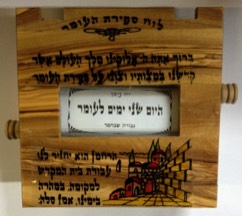
Another Omer Counter. This one in Olive Wood.
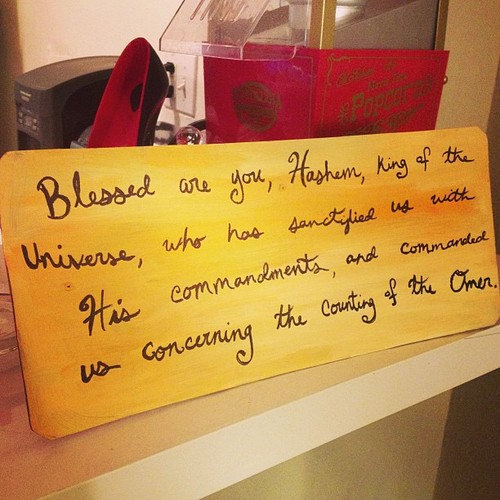
Make a sign to help you remember to count the Omer.
The Blessing
In the daily liturgy, a special passage for announcing the day of the Omer count is included. This, with some modifications, is from Wikipedia:
"As soon as it is definitely night (approximately thirty minutes after sundown), the one who is counting the Omer recites this blessing:
"Baruch atah A-donai E-loheinu Melekh Ha-olam asher kid'shanu b'mitzvotav v'tzivanu al S'firat Ha-omer."
("Blessed are You, Eternal our God, Source of all existence, Who has sanctified us with commandments and commanded us to count the Omer.")
Then he or she states the Omer-count in terms of both total days and weeks and days. For example, on the 23rd day the count would be stated thus: "Today is twenty-three days, which is three weeks and two days of the Omer." The count is said in Hebrew.
According to Jewish law, a person may only recite the blessing while it is still night. If he or she remembers the count the next morning or afternoon, the count may still be made, but without a blessing. If one forgets to count a day altogether, he or she may continue to count succeeding days, but without a blessing.
The Omer may be counted in any language, however one must understand what one is saying.
"As soon as it is definitely night (approximately thirty minutes after sundown), the one who is counting the Omer recites this blessing:
"Baruch atah A-donai E-loheinu Melekh Ha-olam asher kid'shanu b'mitzvotav v'tzivanu al S'firat Ha-omer."
("Blessed are You, Eternal our God, Source of all existence, Who has sanctified us with commandments and commanded us to count the Omer.")
Then he or she states the Omer-count in terms of both total days and weeks and days. For example, on the 23rd day the count would be stated thus: "Today is twenty-three days, which is three weeks and two days of the Omer." The count is said in Hebrew.
According to Jewish law, a person may only recite the blessing while it is still night. If he or she remembers the count the next morning or afternoon, the count may still be made, but without a blessing. If one forgets to count a day altogether, he or she may continue to count succeeding days, but without a blessing.
The Omer may be counted in any language, however one must understand what one is saying.
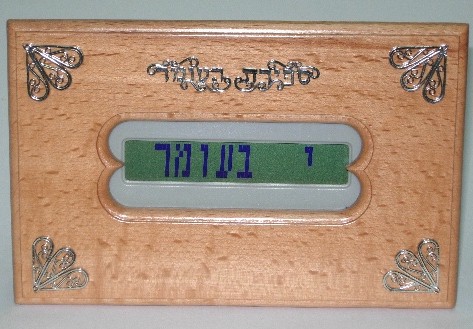
What are the odds that this cheesy, digital Omer Counter isn't made in China? Pretty slim, I'd reckon.
Old and New School Omer Counting Tech
"Omer-counters" are typically offered for sale during this time, and are displayed in synagogues for the benefit of worshippers who count the Omer with the congregation at the conclusion of evening services. Omer-counters range from decorative boxes with an interior scroll that shows each day's count through a small opening; to posters and magnets in which each day's count is recorded on a tear-off piece of paper; to calendars depicting all seven weeks and 49 days of the Omer (a small pointer is advanced from day to day); to pegboards that keep track of both the day and the week of the Omer. Reminders to count the Omer are also produced for hand-held computers and via text message services for cell phones."
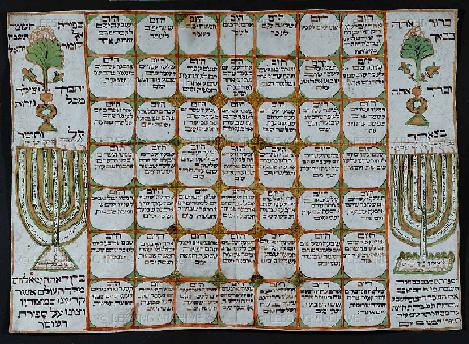
An elaborate, hand-made Omer calendar.
Why Count?
In biblical times, the counting of the was a way of marking our ancestor's concern for a successful, early harvest. The 49 days of counting bridged the time between the early, barley harvest and the next, crucial harvest of the wheat crop. But as the festival of Shavuot became more and more connected with the revelation of Torah at Mount Sinai, new associations with the counting of the omer developed.
Some people see the counting of the days from Pesach to Shavu'ot as analogous to counting the stages of the journey from the Sea Of Reeds to Mount Sinai, the journey from liberation to revelation. This way of looking at the Omer period reminds us that freedom without discipline, or without commitment to worthy ideals, is incomplete. How many times in history has a liberated or oppressed group proven to be at least as brutal as the oppressor they defeated? Freedom can be license to steal and murder. But the journey from Pesach to Shavuot can remind us that freedom itself is only goodness in potential; what matters is what we do with our freedom. The Counting of the Omer is thus a kind of "spiritual GPS" that gets us where we need to go.
As my colleague, Rabbi Josh Zweiback likes to say, the message of Passover is this: "God freed us... for a purpose." Or, as the great writer and Holocaust survivor, Viktor Frankl, z"l, once opined, "The Statue of Liberty on the East Coast should by all rights be balanced by a Statue of Responsibility on the West Coast."
Some people see the counting of the days from Pesach to Shavu'ot as analogous to counting the stages of the journey from the Sea Of Reeds to Mount Sinai, the journey from liberation to revelation. This way of looking at the Omer period reminds us that freedom without discipline, or without commitment to worthy ideals, is incomplete. How many times in history has a liberated or oppressed group proven to be at least as brutal as the oppressor they defeated? Freedom can be license to steal and murder. But the journey from Pesach to Shavuot can remind us that freedom itself is only goodness in potential; what matters is what we do with our freedom. The Counting of the Omer is thus a kind of "spiritual GPS" that gets us where we need to go.
As my colleague, Rabbi Josh Zweiback likes to say, the message of Passover is this: "God freed us... for a purpose." Or, as the great writer and Holocaust survivor, Viktor Frankl, z"l, once opined, "The Statue of Liberty on the East Coast should by all rights be balanced by a Statue of Responsibility on the West Coast."
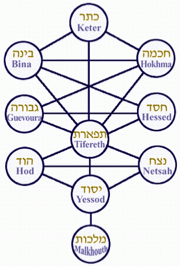
The tree of the Sefirotic System.
In Jewish Mysticism
In Hasidic thought, one finds the tendency to take the events of the Torah narratives as metaphors for internal, psycho-spiritual states. Thus, for example, there's a reading of the Exodus story that takes the enslavement in Egypt as representative of mochin d'katnut, "limited consciousness," and the Exodus as representative of mochin d'gadlut, "expanded consciousness."
Similarly, our there's a tradition that sees the days of the omer as representing an ascent from the idolatry/impurity of Egypt, to a state of heightened consciousness that will allow us to receive Torah on Shavu'ot. What are the stages of this 49-day journey?
The kabbalistic tradition speaks of God's reality in terms of 10 Sefirot, "spheres" or "emanations." These Sefirot are the bridge, or link, between the wholly transcendent, unknowable God, and the material world in which we live, and in which we can experience something of God's presence. Not only that, but these Sefirot are thought to reflect on subtleties of the Divine "personality." And because the Torah tells us that we are created b'tzelem Elohim, in the image of God, the Sefirot reflect aspects of the human personality, as well. These aspects are often called middot, which might be translated "human virtues."
The kabbalistic tradition makes a connection between the seven lower Sefirot and the seven weeks of counting the Omer. Each week is devoted to contemplating and exploring another of the seven lower Sefirot. And because each of the Sefirot contains aspects of all seven, we get 7 x 7, or 49 divine qualities to work with, one for each day of the counting of the Omer. Cool, huh? ;-)
Of course, you don't have to be a hard-core kabbalist to get a lot out of these practices. You can just "get with the program" and see where it takes you.
I'll let Rabbi Art Green's comments from the wonderful book, The Jewish Holidays, A Guide and Commentary, sum this up:
Similarly, our there's a tradition that sees the days of the omer as representing an ascent from the idolatry/impurity of Egypt, to a state of heightened consciousness that will allow us to receive Torah on Shavu'ot. What are the stages of this 49-day journey?
The kabbalistic tradition speaks of God's reality in terms of 10 Sefirot, "spheres" or "emanations." These Sefirot are the bridge, or link, between the wholly transcendent, unknowable God, and the material world in which we live, and in which we can experience something of God's presence. Not only that, but these Sefirot are thought to reflect on subtleties of the Divine "personality." And because the Torah tells us that we are created b'tzelem Elohim, in the image of God, the Sefirot reflect aspects of the human personality, as well. These aspects are often called middot, which might be translated "human virtues."
The kabbalistic tradition makes a connection between the seven lower Sefirot and the seven weeks of counting the Omer. Each week is devoted to contemplating and exploring another of the seven lower Sefirot. And because each of the Sefirot contains aspects of all seven, we get 7 x 7, or 49 divine qualities to work with, one for each day of the counting of the Omer. Cool, huh? ;-)
Of course, you don't have to be a hard-core kabbalist to get a lot out of these practices. You can just "get with the program" and see where it takes you.
I'll let Rabbi Art Green's comments from the wonderful book, The Jewish Holidays, A Guide and Commentary, sum this up:
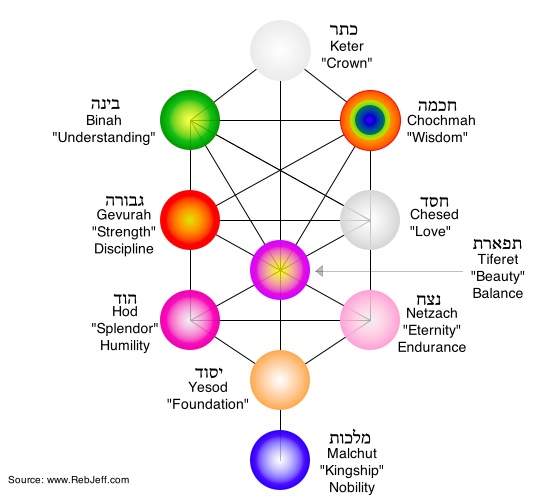
"The 49 days form a multiplication of seven times the seven Sefirot, which represent aspects of both the divine and human personalities: Hesed (love), Gevurah (power, judgment, including anger), Tiferet (glory, pride, also inner balance), Netzach (triumph, aggrandizement), Hod (beauty), Yesod, (the “foundation,” including sexual energy), and Malchut (kingship, authority, but also the feminine component in the male personality). Each of the seven in turn contains all seven within itself, making a total of 49 inner aspects of the divine/human self. On each day of the counting… [we] seek to restore or elevate within ourselves the combination of the Sefirot belong to that day. This is readily comprehensible on a moralistic or psychological level, which is the way many Hasidim read the cabalistic system. Thus, on the first day of the Omer (the count begins from above) one works on the Hesed within Hesed, on the purest love the soul can find within itself. On the second day, attention is focused on the Gevurah within Hesed, the anger or judgment within one's love; the third day on Tiferet in Hesed, the glory or perhaps a self-glorification that lies within love; and so forth. In the second week the focus is on Gevurah, beginning with Hesed in Gevurah, the love inside the judgment, and proceeding through the system. Thus the counting becomes a series of meditative and morally restorative exercises, purging the self and preparing to stand again at Sinai.”
Now, get to the blog and let's begin…
